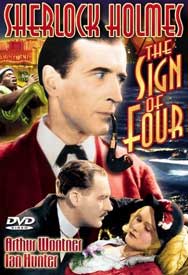 A one-legged thug in prison makes an arrangement with two guards, Sholto & Morston (Herbert Lomas & Edgar Norfolk), to reveal the location in the Fortress of Agra where a treasure is hidden, in exchange for his share & the opportunity to escape from the prison where he's doing a life sentence. A one-legged thug in prison makes an arrangement with two guards, Sholto & Morston (Herbert Lomas & Edgar Norfolk), to reveal the location in the Fortress of Agra where a treasure is hidden, in exchange for his share & the opportunity to escape from the prison where he's doing a life sentence.
He promises to be far too dangerous to doublecross. Yet upon finding such wealth, the guards immediately turn on each other. One of them, Morston, is left behind dead; the one-legged man is betrayed.
The Sign of the Four (1934) starring Arthur Wontner as Sherlock Holmes & Ian Fleming as Dr. John Watson is the third film version & first talkie based on the famous tale by Arthur Conan Doyle.
The script is not internally consistent. On the one hand the murderer who absconded with the fortune, in his old age, tells his two sons that the family's wealth began with this ill-gotten treasure. On the other hand, none of the jewels have ever been sold, but have been kept fearfully hidden away.
So too the one-legged man, Jonathan Smalls (Graham Soutten), seems not to have aged a day when he finally does escape, though the man who betrayed him got old & wheelchair bound & died of a heart attack the instant he saw Smalls' face peering in at a window.
In any case, finally Smalls escapes prison, bringing with him a henchman who is covered in tattoos. Again the story is rather less than sensible since the tattooed man (Roy Emerton) claims to have had only a few weeks left on his term, but was willing to break out of prison & live life on the run on some violent lifer's promise of jewels.
It's twenty minutes into the film before we're introduced to two gentlemen sharing, Holmes & Watson, their appearance & apartment strongly patterned on the original illustrations for The Strand Magazine wherein Sherlock Holmes was first featured.
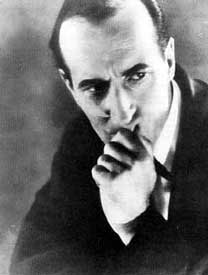 Though visually close to the original inside Holmes & Watson's apartment, Holmes is otherwise uniquely interpreted as an upbeat character with tendency to jest, & Watson much more his equal than the well-meaning foil encountered in other film versions of sundry Holmes adventures. Nor is there any effort made to match the other characters or settings to Holmes' Victorian world, & the leading lady is something of a flapper with a Jean Harlow look, the film apparently set in 1932 when the film was made. Though visually close to the original inside Holmes & Watson's apartment, Holmes is otherwise uniquely interpreted as an upbeat character with tendency to jest, & Watson much more his equal than the well-meaning foil encountered in other film versions of sundry Holmes adventures. Nor is there any effort made to match the other characters or settings to Holmes' Victorian world, & the leading lady is something of a flapper with a Jean Harlow look, the film apparently set in 1932 when the film was made.
Mary Morston (Isla Bevan), the daughter of the slain partner, receives a string of pearls by delivery, from Major Sholto's sons (Miles Malleson & Kynaston Reeves) who've been instructed to share the treasure with the murdered man's heir. Shortly thereafter she receives threats from the one-legged man & the tattooed man, inducing her to seek out the assistance of Sherlock Holmes.
Soon one of the two brothers is slain in a locked room by means of a poison dart from a blowgun, & the bulk of the treasure is missing, except for the pearls Mary has hidden. Holmes leaps into action following far-fetched clues to a carnival & taking a very active fisticuffs role in recovering the jewels, saving the maiden, & killing Jonathan Smalls, albeit in self defense against Smalls who is good at karate kicks with his wooden leg.
Watson is extremely helpful & active & like Holmes skilled in a fistfight, rather than his usual observer self. Mary Morston is sufficiently impressed to have fallen in love with Watson by the end & they're to be married.
Sign of the Four is a charming though entirely trivial film with some moody moments & quite an appealing actor in the central role. The nonsensical deductions of Holmes are quaintly comical, the more so for the posturing sincerity of their presentation. The villains are colorful to extreme, man with wooden leg, tattooed henchman, & Tonga the snake-handling African (played by "Togo"), & there's an amusing sequence with Holmes undercover in the guise of a drunken old sea captain with putty nose.
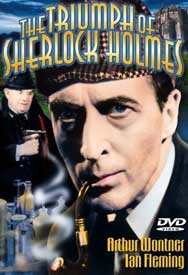 Not even Dr Watson (Fleming) quite believes Holmes (Wontner) insistence that the innocuous old Professor Moriarty (Lyn Harding) is a master criminal. And The Triumph of Sherlock Holmes (1935) would be to bring Moriarity to justice & not incidentally justify to all what so many believe to be a mistaken obsession. Not even Dr Watson (Fleming) quite believes Holmes (Wontner) insistence that the innocuous old Professor Moriarty (Lyn Harding) is a master criminal. And The Triumph of Sherlock Holmes (1935) would be to bring Moriarity to justice & not incidentally justify to all what so many believe to be a mistaken obsession.
Watson is now married & no longer lives with Holmes, whose Baker Street residence is being packed up as he prepares to retire to the countryside. His one regret is that he's retiring without first unmasking Moriarity.
The vile Professor meanwhile is in cahoots with an American gangster intent on assassinating an ex-member of a sinister secret society called the Scowlers. The target now lives reclusively under an assumed name, not far distant from Holmes' Sussex cottage.
At his Sussex residence, caring for honeybees & a garden, Holmes is quite adjusted to a slower lifestyle. He's nevertheless easily baited out of his retirement by a clue that promises to stop one of Moriarity's future crimes. Alas, that tantalizing promise is unmet, & the murder does occur, but by now Holmes is in the game, gathering clues like the half burnt candle, a missing dumbbell, & a misidentified face-mutilated corpse.
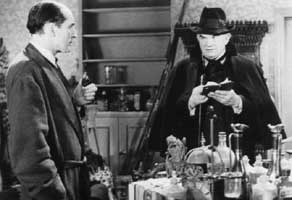 As the crime comes closer to resolution, Moriarity has seemed not to have been involved in any of it, & Holmes' insistence to the contrary still seems obsessive rather than well founded. But Holmes is on the cusp of unveiling one more level to the crimes as he investigates the shadows of the Norman castle tower. As the crime comes closer to resolution, Moriarity has seemed not to have been involved in any of it, & Holmes' insistence to the contrary still seems obsessive rather than well founded. But Holmes is on the cusp of unveiling one more level to the crimes as he investigates the shadows of the Norman castle tower.
The climax incorporates a chase up the spooky castle tower, & a seemingly definitive conclusion for Moriarity's career, not that that will keep him from showing up for another go at Arthur Wontner's Holmes in the next film of the series.
The Triumph of Sherlock Holmes, derived or condensed from Arthur Conan Doyles' serial novel The Valley of Fear (1914-1915), verges on being a good film. It is at the very least an idle amusement for everyone interested in the history of Sherlock Holmes in the cinema. For such a low budget, the cinematography is moody with some of the lighting FX expected more of film noir in the 1940s & 50s.
As ever, Wontner, conveying a Holmes with a wonderful sense of humor, is physically a dead-ringer for the Holmes imagined by illustrator Sidney Paget in the pages of The Strand, a perfect semblance not equalled until Jeremy Brett so ably took on the role many decades later.
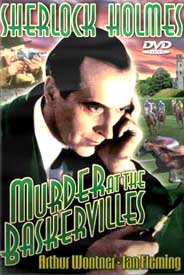 Murder at the Baskervilles (aka, Silver Blaze, 1937) is adapted in the main from the A. Conan Doyle novelette "Silver Blaze" (1892). It retains many of the original tales' clues & ingredients despite that characters from unrelated stories have shoehorned into this film adaptation. Murder at the Baskervilles (aka, Silver Blaze, 1937) is adapted in the main from the A. Conan Doyle novelette "Silver Blaze" (1892). It retains many of the original tales' clues & ingredients despite that characters from unrelated stories have shoehorned into this film adaptation.
Twenty years after the events of "The Hound of the Baskervilles" Holmes accepts an invitation to revisit Sir Henry Baskerville's estate, his old friend Watson in tow.
He's not been on the estate long when the champion race horse Silver Blaze goes missing & the horse's groom left dead of poison. A young trainer is suspect by everyone except Holmes & Sir Henry's daughter.
Holmes detects the hand of Professor Moriarity (again played by Lyn Harding), without regard for the fact that Moriarity fell to his death in the previous episode, The Triumph of Sherlock Holmes.
Moriarity has established himself in an underground fortress & is clearly a mite paranoid, justifiably so, about Sherlock Holmes. When he is first hired to sabotage the career of Silver Blaze, he doesn't expect Holmes to turn up. When once again he discovers Holmes interfering, Moriarity is quick to plot out Holmes' demise.
Murder & the race track make for a colorful combination. One odd little touch is a silent gun invented by Moriarity, an almost science fictional touch in passing. Another fun touch is the surprising identity of a second murderer.
This was Wontner's final outing as Sherlock Holmes, & a jolly farewell to the role it makes. Though very few fans would say Wontner is their favorite Holmes, just about everyone admits he fit the role awfully well, & projected a wittier Holmes a bit less nutty than the original while still eccentric.
These three films are easily obtained, but restored remastered clear sharp transfers (as I write these reviews) do not exist. So a viewer has to take an attitude that such old films are still fine to watch with the sound & look of damaged antiques.
Perhaps someday some company will think it worth restoring the entire set, including the earlier two which are presently difficult to track down, for a five-film Wontner set including The Sleeping Cardinal (aka, Sherlock Holmes' Fatal Hour, 1931) & The Missing Rembrandt (1932).
copyright © by Paghat the Ratgirl
|
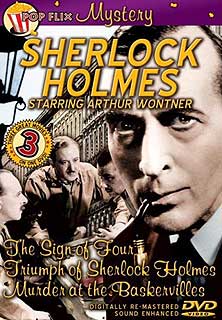

 Though visually close to the original inside Holmes & Watson's apartment, Holmes is otherwise uniquely interpreted as an upbeat character with tendency to jest, & Watson much more his equal than the well-meaning foil encountered in other film versions of sundry Holmes adventures. Nor is there any effort made to match the other characters or settings to Holmes' Victorian world, & the leading lady is something of a flapper with a Jean Harlow look, the film apparently set in 1932 when the film was made.
Though visually close to the original inside Holmes & Watson's apartment, Holmes is otherwise uniquely interpreted as an upbeat character with tendency to jest, & Watson much more his equal than the well-meaning foil encountered in other film versions of sundry Holmes adventures. Nor is there any effort made to match the other characters or settings to Holmes' Victorian world, & the leading lady is something of a flapper with a Jean Harlow look, the film apparently set in 1932 when the film was made.
 As the crime comes closer to resolution, Moriarity has seemed not to have been involved in any of it, & Holmes' insistence to the contrary still seems obsessive rather than well founded. But Holmes is on the cusp of unveiling one more level to the crimes as he investigates the shadows of the Norman castle tower.
As the crime comes closer to resolution, Moriarity has seemed not to have been involved in any of it, & Holmes' insistence to the contrary still seems obsessive rather than well founded. But Holmes is on the cusp of unveiling one more level to the crimes as he investigates the shadows of the Norman castle tower.